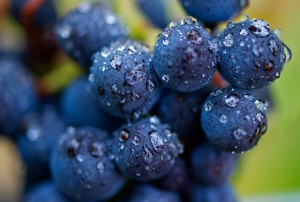 Things that are often described as difficult, high risk, and overly sensitive are nearly always worth both the wait and the trouble–yeah, damn right that includes me. So, I tend to have a weak spot for a really well-made pinot noir because I know that both the grower and the winemaker didn’t take the easy way out…by planting some cabernet instead, or by making shitty pinot because they just didn’t get the grape. The famous CA winemaker André Tchelistcheff once said that, “God made cabernet sauvignon whereas the devil made pinot noir.” A friend of the devil is always a friend of mine.
Things that are often described as difficult, high risk, and overly sensitive are nearly always worth both the wait and the trouble–yeah, damn right that includes me. So, I tend to have a weak spot for a really well-made pinot noir because I know that both the grower and the winemaker didn’t take the easy way out…by planting some cabernet instead, or by making shitty pinot because they just didn’t get the grape. The famous CA winemaker André Tchelistcheff once said that, “God made cabernet sauvignon whereas the devil made pinot noir.” A friend of the devil is always a friend of mine.
It isn’t as simple as old world vs. new world, because Burgundy manages to churn out plenty of subpar pinot nowadays, too. Just because it’s where the heartbreak grape has historically made some of the most seductive wines this world has known, doesn’t mean it’s without greed, stupidity and laziness. Plenty of pinots coming from France are either too fat, too thin, too ripe, too green or too high octane. And the wineries making them blame either a bad year, a finicky grape or a foreign market (that would be us) that wants a pinot that tastes like a fucking zinfandel. And to that end they either throw their hands up, not knowing how to properly coax the best of a grape that is, no doubt, a pain in the ass to grow, or they make wines that no longer resemble anything close a classic red Burgundy, in hopes to boost sales in the US market. You are far more likely to find a wide audience in those who suck at the teat of Coca-Cola and enjoy overly fruity, full-bodied wines than you are in those who appreciate the lithe earthiness of pinot at its best. Pinot never wanted to placate the masses. Pinot is the grape that flips the bird at the masses. But there are always plenty of idiots who won’t let it do what it wants to do.
The pendulum is thankfully swinging the other way in California winemaking now, and many winemakers are returning to a more natural approach to the juice they stick in their bottles. And no, this ain’t about organic winemaking. This is about making a merlot that has the classic (natural) characteristics of a merlot…not of a shiraz. The last couple of decades, California spent a lot of time whoring itself to the public’s cry for homogenized wines. And though I’ve seen plenty of CA finally putting its foot down, making wines that are distinctive, true to their nature and individual in style, pinot noirs are not, overall, being nurtured back to a world of normalcy. Pinots are still the black sheep in most of California. The ones that are forced into becoming something they aren’t…something that tastes like everything else. The ones that should be the embodiment of sexuality, and instead become the embodiment of that size 18 woman at the beach walking around in a size 8 bikini.
 But this is how I know that California pinot is not dead yet. La Pitchoune. Somewhere in Sonoma there are some pinot grapes that are being painstakingly grown, patiently cared for and allowed to do their thing in what can only be described as a sort of subservience to the magic of the grape. Andrew Berge isn’t making wine as much as he is growing grapes. And more importantly, he is allowing them to become some of the best pinot noir being made on the west coast. Not because it closely resembles a classic red Burgundy (although it does), but because it DOESN’T resemble anything else but a pinot noir. There is no jam. There is no oak tree. There is no nose-hair-singeing ABV. There is only sexy, earthy, softly curved but beautifully edged pinot. Charles Bukowski wrote, “She may be mad but she’s magic. There’s no lie in her fire.” That woman that comes along once in your lifetime, if you’re lucky, and drives you absolutely batshit crazy at times but also exudes more intoxicating character and beauty than you’ve ever experienced before in one person before? That’s pinot. More specifically, that’s the pinot being made at La Pitchoune.
But this is how I know that California pinot is not dead yet. La Pitchoune. Somewhere in Sonoma there are some pinot grapes that are being painstakingly grown, patiently cared for and allowed to do their thing in what can only be described as a sort of subservience to the magic of the grape. Andrew Berge isn’t making wine as much as he is growing grapes. And more importantly, he is allowing them to become some of the best pinot noir being made on the west coast. Not because it closely resembles a classic red Burgundy (although it does), but because it DOESN’T resemble anything else but a pinot noir. There is no jam. There is no oak tree. There is no nose-hair-singeing ABV. There is only sexy, earthy, softly curved but beautifully edged pinot. Charles Bukowski wrote, “She may be mad but she’s magic. There’s no lie in her fire.” That woman that comes along once in your lifetime, if you’re lucky, and drives you absolutely batshit crazy at times but also exudes more intoxicating character and beauty than you’ve ever experienced before in one person before? That’s pinot. More specifically, that’s the pinot being made at La Pitchoune.




{ 11 comments… read them below or add one }
This was a delight to read. Nice work. Thanks for good, smart words.
Thanks Tom. The spark to write is “not dead yet” lol. They are making great wines.
It’s good to see you back posting! Glad to know your still around!
I see you’ve described the California wines, but I’m from NY. Are there any wines up in my area (Orange County NY) that you would recommend? I’m still new at this wine thing because i’m more of a beer drinker. But I know we have some wineries up in the NY country area?
I also like to support any local businesses, so if you could point me in the right direction, it would be greatly appreciated. Side not, its good to know your still with us!! Thanks again for everything. 🙂
Warwick Valley Winery is a great winery, and a distillery too! They also have live music more and more now as the weather gets warmer. Their hard cider is fantastic as well, and the grounds are great for just kicking back. I love trekking the Shawangunk Trail and its wineries.
Can’t wait to read the next Gonzo Gastronomy post in October …
BTW…there are not many eyebrows better than ol’ Andre’s
http://www.marialobanovsky.com/wp-content/uploads/2013/05/andre_tchelistcheff_img_0.jpg
Agreed Lou. And better a little Gonzo than no Gonzo 😉
Excellent read. I often think that there are so many bad pinots on the market that trying to find a decent one has worse odds than just a crap shoot. Then again, maybe I am just not a pinot guy. [shrugs]
There are TONS of bad pinots on the market. I don’t often gamble on them. It’s either a reco, an importer I trust, or something i know i love.
California wineries have been producing distinctive wines for years, if one knows where to look.
The problem is speaking of California as a singularly operating entity. It’s a state with regions strewn all up and down it’s 800-something miles of land. It is a region with 4,000 wineries. 4,000 wineries, and most of them we cannot access here on the East Coast. I for one am not into discussing California as something to be viewed in a singular way. It simplifies what is a complex wine region, perhaps the most complex in the world.
I think it’s pretty evident in the piece that I am talking about the bulk of California wine that lines our store shelves. And there was undoubtedly a swing in the state overall, during the last couple of decades (80s and 90s), to placate a new generation of wine drinkers that wanted wines that were potable “today” and to also create wines that were ratings-seekers. The ABVs started inching upward, the oak became a main character instead of a supporting role, and finding a chardonnay on the shelf that saw NO OAK was nearly impossible. What I am discussing are winemaking trends. And to say that there wasn’t one in California is to gloss over history. And it is also convenient to ignore the regions of CA that are making pinots when they probably shouldn’t be if they want it taste like a pinot. I also mention that the pendulum is swinging, and that more of the CA juice on east coast is actually eschewing all the score chasing and the homogenization, and making distinctive wines. Lodi, for instance, has always been viewed as a high-octane wine region. Many winemakers there are turning that notion on its head and making beautifully balanced wines. Thus even in discussing particular regions, there is still a history of winemaking trends.